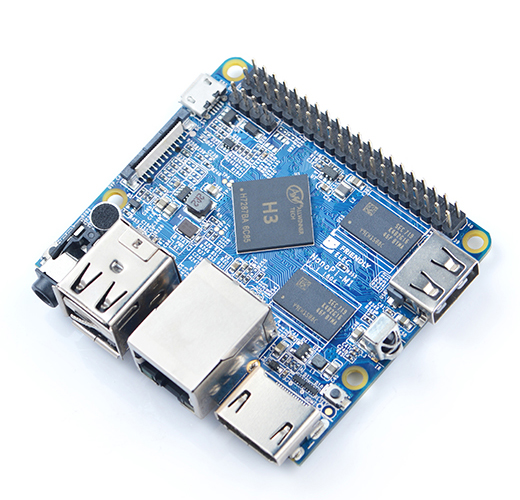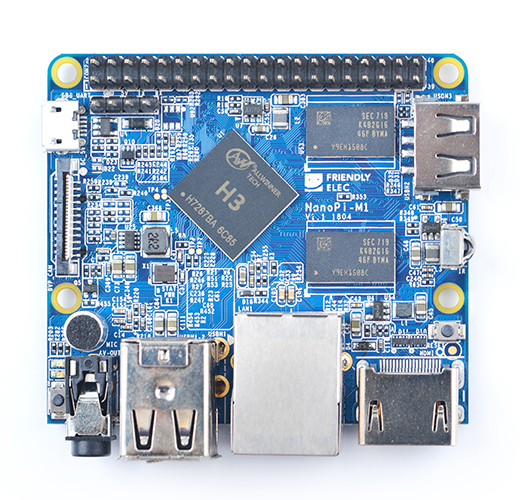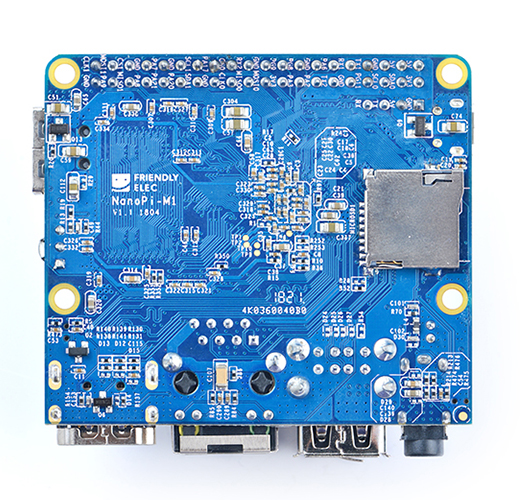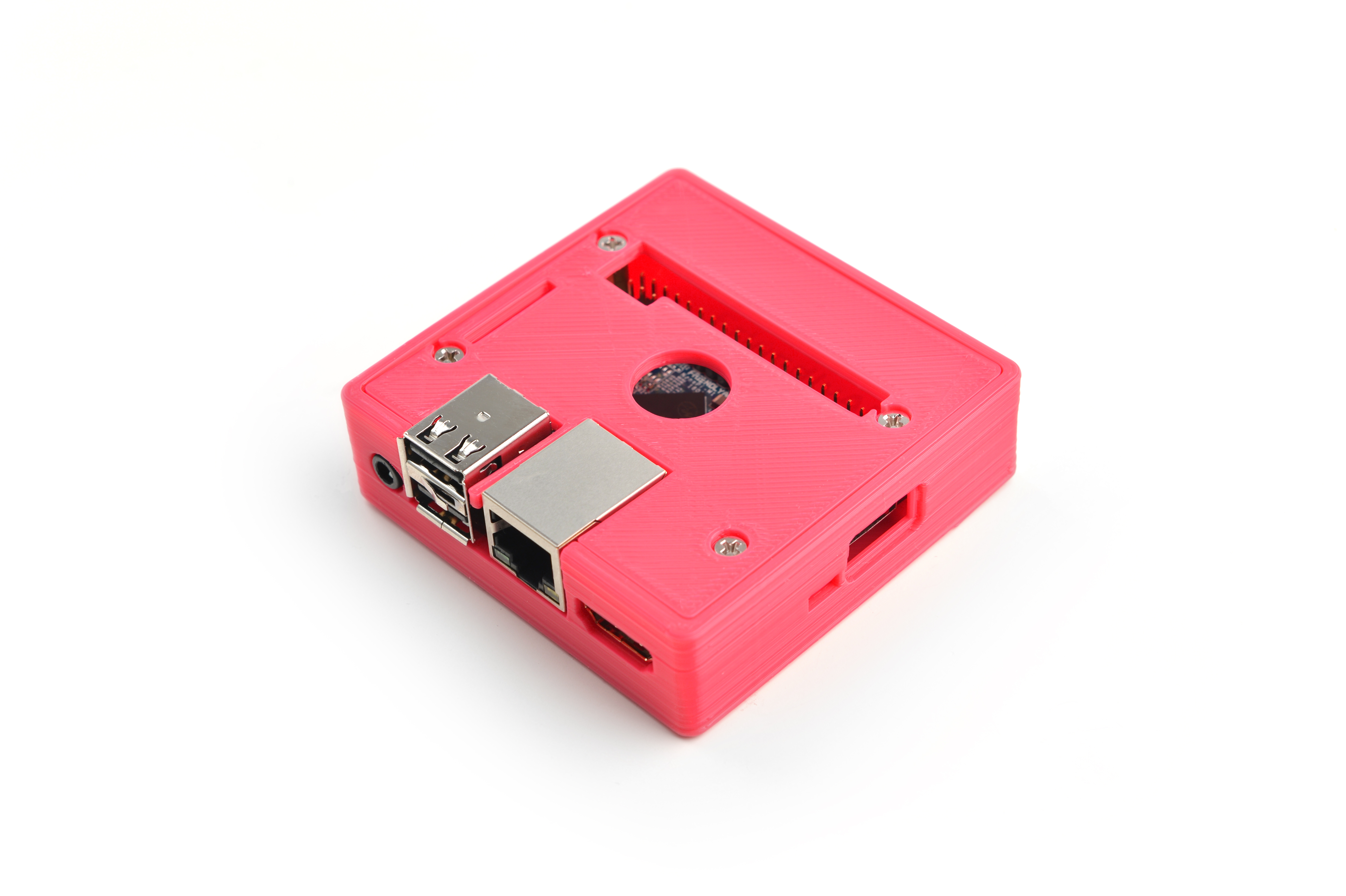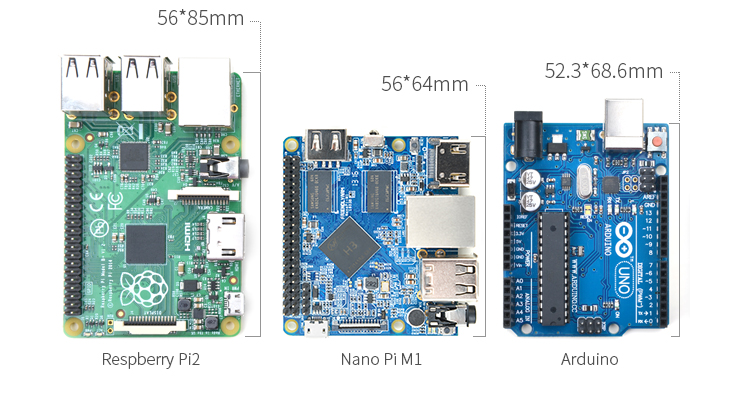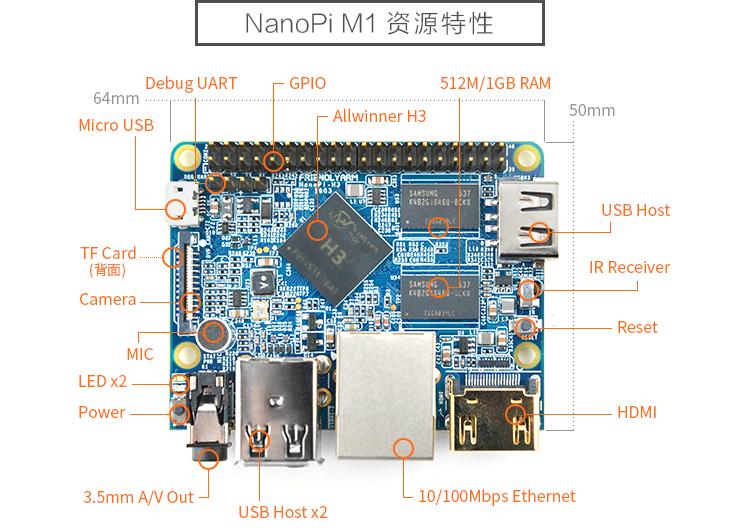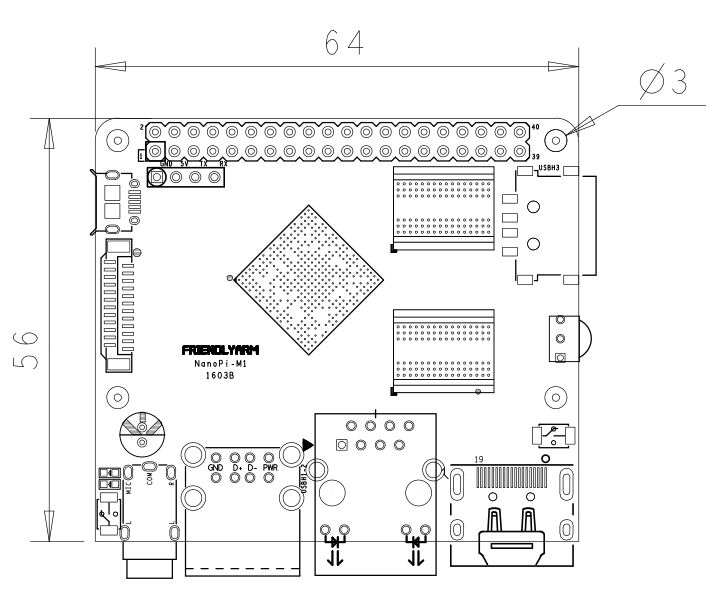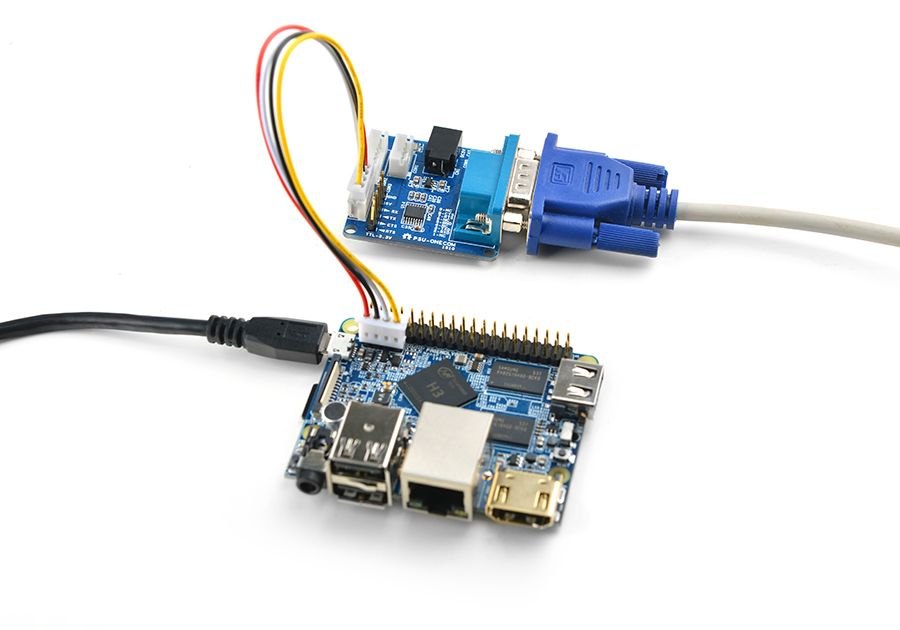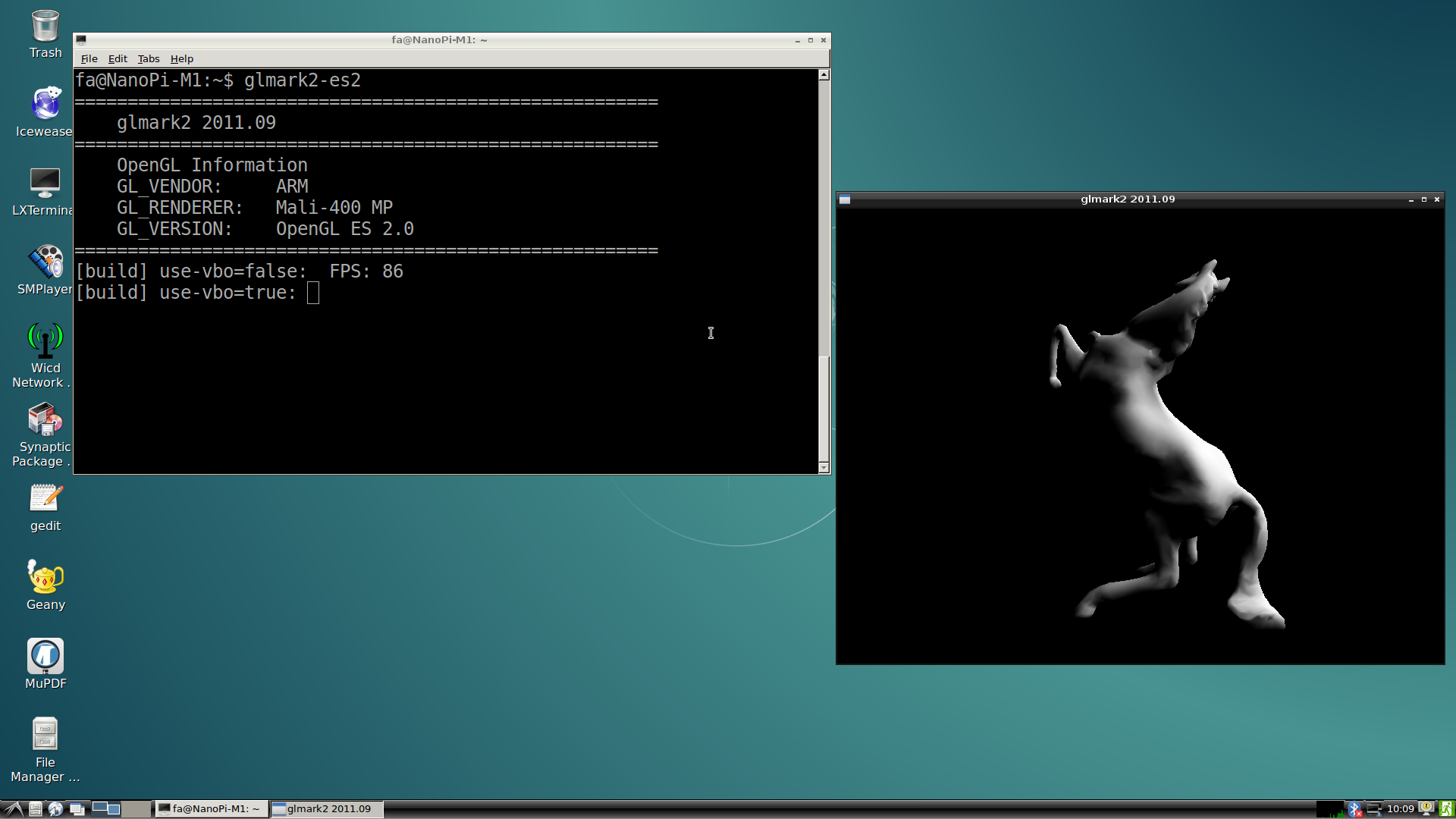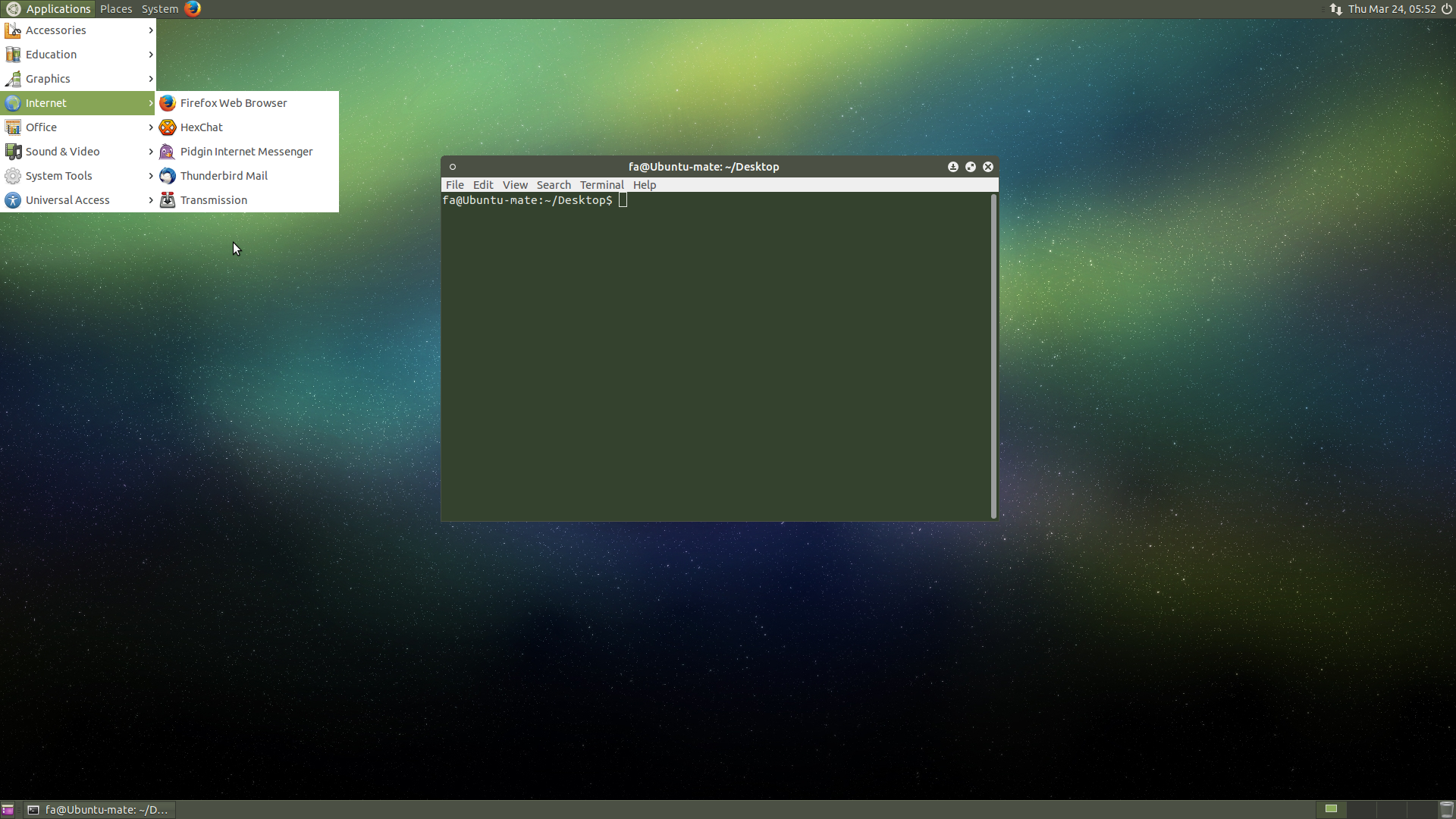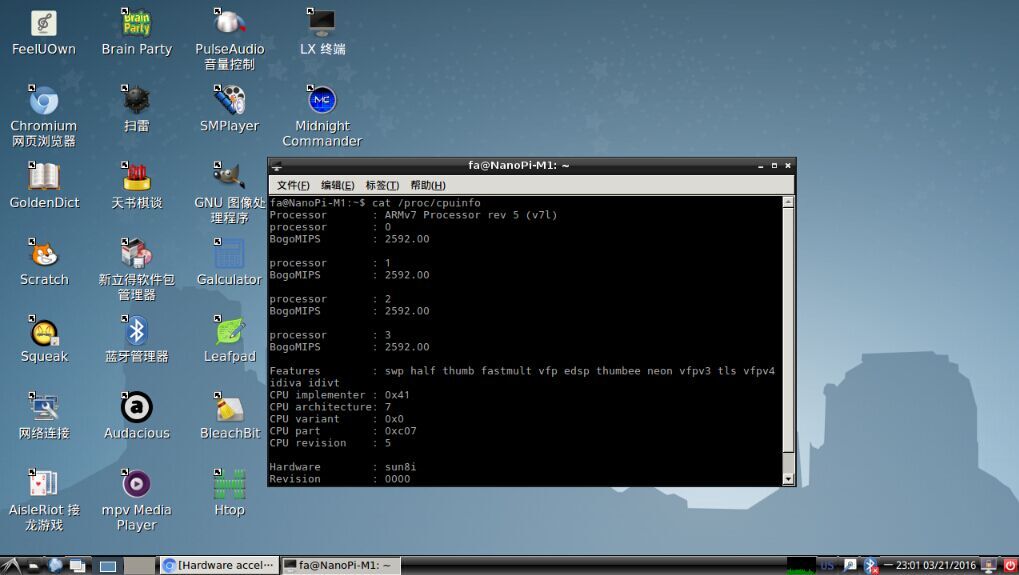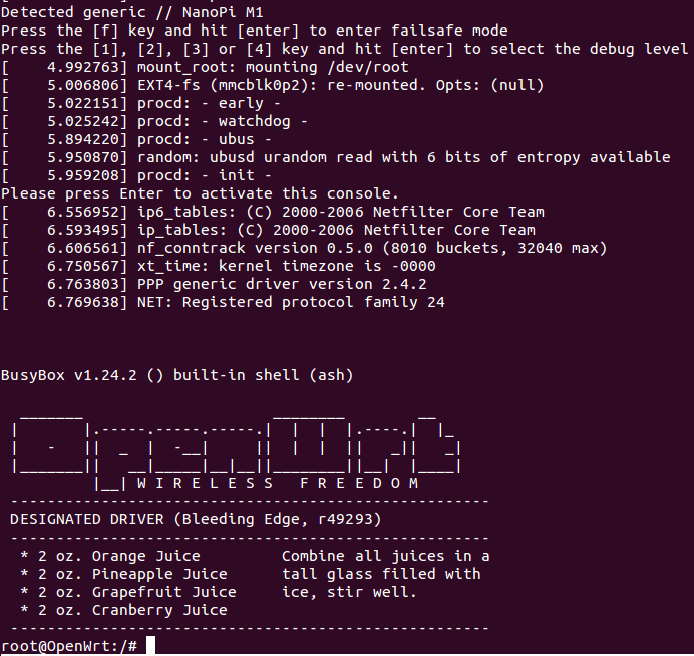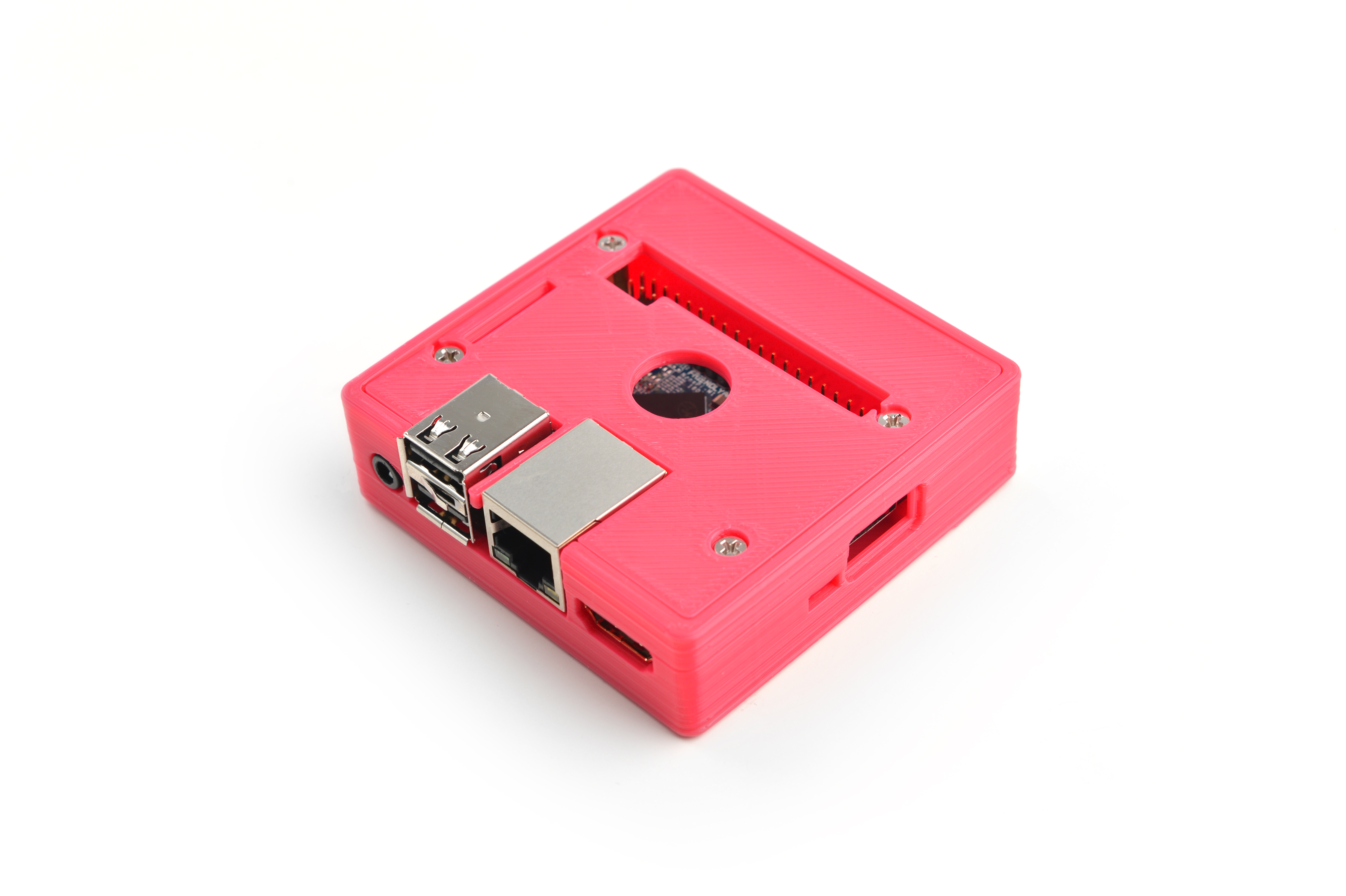Difference between revisions of "NanoPi M1"
(→HDMI Audio Output) |
(→Preparations) |
||
| Line 438: | Line 438: | ||
==Make Your Own Debian== | ==Make Your Own Debian== | ||
===Preparations=== | ===Preparations=== | ||
| − | Visit this link [ | + | Visit this link [https://www.mediafire.com/folder/u05rynncjgkse/sources] and enter the sources directory to download the nanopi-H3-bsp source code.Use the 7-zip utility to uncompress it and a lihee directory and an Android directory will be generated. Or you can get it from our github: |
<syntaxhighlight lang="bash"> | <syntaxhighlight lang="bash"> | ||
git clone https://github.com/friendlyarm/h3_lichee.git lichee | git clone https://github.com/friendlyarm/h3_lichee.git lichee | ||
Revision as of 02:03, 27 December 2016
Contents
- 1 Introduction
- 2 Hardware Spec
- 3 Diagram, Layout and Dimension
- 4 Get Started
- 5 Working with Debian
- 5.1 Run Debian
- 5.2 Extend TF Card's rootfs Section
- 5.3 Ethernet Connection
- 5.4 Login to Debian via VNC and SSH
- 5.5 HDMI Resolution
- 5.6 HDMI Audio Output
- 5.7 Test GPU
- 5.8 Test VPU
- 5.9 Test USB WiFi
- 5.10 Connect NanoPi M1 to DVP Camera CAM500B
- 5.11 Connect NanoPi M1 to USB Camera(FA-CAM202)
- 5.12 Use OpenCV to Access Camera
- 5.13 Check CPU's Working Temperature
- 6 Make Your Own Debian
- 7 Applications under Android
- 8 Make Your Own Android
- 9 More OS Support
- 10 3D Housing Printing Files
- 11 Matrix Compact Kit B:A Good Kit for Starters
- 12 Resources
- 13 Update Log
1 Introduction
- The NanoPi M1 is an Allwinner H3 based ARM board designed and released by FriendlyARM for hobbyists, makers and electronic fans. It is only two thirds the size of the Raspberry Pi. It is open source. It works with Ubuntu MATE, Debian and etc.
- The NanoPi M1 uses the Allwinner H3 Soc. It integrates Ethernet, IR receiver, video/audio output and supports HDMI and AVOUT. It can be powered via the MicroUSB port
- In such a small board it still integrates rich interfaces and ports. Besides the popular HDMI, Ethernet, USB-Host, USB-OTG, DVP camera interface and AVOUT (audio and video) it has an onboard Microphone, IR receiver, a serial debug port and a Raspberry Pi compatible 40 pin GPIO pin header.
2 Hardware Spec
- CPU: Allwinner H3, Quad-core Cortex-A7@1.2GHz
- GPU: Mali400MP2@600MHz,Supports OpenGL ES2.0
- DDR3 RAM: 512MB/1GB
- Connectivity: 10/100M Ethernet
- Audio: 3.5mm audio jack/Via HDMI
- Microphone: Onboard microphone
- IR Receiver: Onboard IR receiver
- USB Host:Type A, USB 2.0 x 3
- MicroSD Slot x 1
- MicroUSB: for data transmission and power input, OTG
- Video Output: HDMI 1.4 1080P, CVBS
- DVP Camera Interface: 24pin, 0.5mm pitch FPC seat
- Debug Serial Port: 4Pin, 2.54mm pitch pin header
- GPIO: 2.54mm spacing 40pin, compatible with Raspberry Pi's GPIO. It includes UART, SPI, I2C, IO etc
- User Key: Power LED x 1, Reset x 1
- PC Size: 64 x 56mm
- Power Supply: DC 5V/2A
- OS/Software: u-boot,Ubuntu MATE,Debian
3 Diagram, Layout and Dimension
3.1 Layout
- GPIO Pin Spec
Pin# Name Linux gpio Pin# Name Linux gpio 1 SYS_3.3V 2 VDD_5V 3 I2C0_SDA 4 VDD_5V 5 I2C0_SCL 6 GND 7 GPIOG11 203 8 UART1_TX/GPIOG6 198 9 GND 10 UART1_RX/GPIOG7 199 11 UART2_TX/GPIOA0 0 12 PWM1/GPIOA6 6 13 UART2_RTS/GPIOA2 2 14 GND 15 UART2_CTS/GPIOA3 3 16 UART1_RTS/GPIOG8 200 17 SYS_3.3V 18 UART1_CTS/GPIOG9 201 19 SPI0_MOSI/GPIOC0 64 20 GND 21 SPI0_MISO/GPIOC1 65 22 UART2_RX/GPIOA1 1 23 SPI0_CLK/GPIOC2 66 24 SPI0_CS/GPIOC3 67 25 GND 26 SPDIF-OUT/GPIOA17 17 27 I2C1_SDA/GPIOA19/PCM0_CLK/I2S0_BCK 19 28 I2C1_SCL/GPIOA18/PCM0_SYNC/I2S0_LRCK 18 29 GPIOA20/PCM0_DOUT/I2S0_SDOUT 20 30 GND 31 GPIOA21/PCM0_DIN/I2S0_SDIN 21 32 GPIOA7 7 33 GPIOA8 8 34 GND 35 UART3_CTS/SPI1_MISO/GPIOA16 16 36 UART3_TX/SPI1_CS/GPIOA13 13 37 GPIOA9 9 38 UART3_RTS/SPI1_MOSI/GPIOA15 15 39 GND 40 UART3_RX/SPI1_CLK/GPIOA14 14
- Debug Port(UART0)
Pin# Name 1 GND 2 VDD_5V 3 UART_TXD0 4 UART_RXD0
- DVP Camera IF Pin Spec
Pin# Name Description 1, 2 SYS_3.3V 3.3V power output, to camera modules 7,9,13,15,24 GND Gound, 0V 3 I2C2_SCL I2C Clock Signal 4 I2C2_SDA I2C Data Signal 5 GPIOE15 Regular GPIO, control signals output to camera modules 6 GPIOE14 Regular GPIO, control signals output to camera modules 8 MCLK Clock signals output to camera modules 10 NC Not Connected 11 VSYNC vertical synchronization to CPU from camera modules 12 HREF/HSYNC HREF/HSYNC signal to CPU from camera modules 14 PCLK PCLK signal to CPU from camera modules 16-23 Data bit7-0 data signals
- Note:
- SYS_3.3V: 3.3V power output
- VDD_5V: 5V power input/output. When the external device’s power is greater than the MicroUSB’s the external device is charging the board otherwise the board powers the external device. The input range is 4.7V ~ 5.6V
- All pins are 3.3V and output current is 5mA. It can drive small loads. No IO pins can drive a load.
- For more details refer to the document: NanoPi-M1-1603B-Schematic.pdf
3.2 Board Dimension
- For more details please refer to: pcb file in dxf
4 Get Started
4.1 Essentials You Need
Before starting to use your NanoPi M1 get the following items ready
- NanoPi M1
- microSD Card/TFCard: Class 10 or Above, minimum 8GB SDHC
- microUSB power. A 5V/2A power is a must
- HDMI monitor
- USB keyboard and mouse
- A host computer running Ubuntu 14.04 64 bit system
4.2 TF Cards We Tested
To make your NanoPi M1 boot and run fast we highly recommend you use a Class10 8GB SDHC TF card or a better one. The following cards are what we used in all our test cases presented here:
- SanDisk TF 8G Class10 Micro/SD TF card:
- SanDisk TF128G MicroSDXC TF 128G Class10 48MB/S:
- 川宇 8G C10 High Speed class10 micro SD card:
4.3 Make an Installation TF Card
4.3.1 Get Image Files
Visit this link download link to download image files and the flashing utility:
Image Files nanopi-m1-debian-sd4g.img.zip Debian Image File nanopi-m1-android.img.zip Android Image File Flash Utility: win32diskimager.rar Windows utility for flashing Debian image. Under Linux users can use "dd" PhoenixCard_V310.rar Windows utility for flashing Android image. Attention: the "dd" command under Linux doesn't work for flashing Android image HDDLLF.4.40.exe Windows utility for formatting a TF card
4.3.2 Make Debian Image Card
- Uncompress the nanopi-m1-debian-sd4g.img.zip and win32diskimager.rar files. Insert a TF card(at least 4G) into a Windows PC and run the win32diskimager utility as administrator. On the utility's main window select your TF card's drive, the wanted image file and click on "write" to start flashing the TF card.
- Insert this card into your NanoPi M1's BOOT slot and power on (with a 5V/2A power source). If the green LED is on and the blue LED is blinking this indicates your NanoPi M1 has successfully booted.
4.3.3 Make Android Image Card
- On a Windows PC run the HDDLLF.4.40 utility as administrator. Insert a TF card(at least 4G) into this PC and format it. After formatting is done take out the TF card, insert it into the PC again and format it with Windows internal format utility to format it to FAT32. After this formatting is done take out the card.
- Uncompress the nanopi-m1-android.img.zip and PhoenixCard_V310.rar files. Insert the TF card you made in the previous step into a Windows PC and run the PhoenixCard_V310 utility as administrator. On the utility's main window select your TF card's drive, the wanted image file and click on "write" to start flashing the TF card.
- Insert this card into your NanoPi M1's BOOT slot and power on (with a 5V/2A power source). If the green LED is on and the blue LED is blinking this indicates your NanoPi M1 has successfully booted.
Note: you must format your TF card before you start making it an Android image card.
5 Working with Debian
5.1 Run Debian
- Insert a TF card with Debian image files into your NanoPi M1, connect the NanoPi M1 to an HDMI monitor and a 5V/2A power source the NanoPi M1 will be automatically powered on. If you can see the blue LED flashing it means your board is working and you will see Debain being loaded on the HDMI monitor.
1)If you connect the NanoPi M1 to an HDMI monitor you need to use a USB mouse and a USB keyboard to operate.
2) If you want to do kernel development you need to use a serial communication board, ie a PSU-ONECOM board, which will allow you to operate the board via a serial terminal.
- Here is a setup where we connect a NanoPi M1 to a PC via the PSU-ONECOM and you can power on your M1 from either the PSU-ONECOM or M1's MicroUSB:
- The password for "root" is "fa".
- Update packages
sudo apt-get update
5.2 Extend TF Card's rootfs Section
We strongly recommend you to do this right after you have made an installation TF card since this will greatly enhance your M1's experience.
Insert your TF card into a host PC and run the following commands on your PC's terminal:
sudo umount /dev/sdx? sudo parted /dev/sdx unit % resizepart 2 100 unit MB print sudo resize2fs -f /dev/sdx2
Note: you need to replace "/dev/sdx" with the device name in your system
- If you want to resize the rootfs section of the TF card run the following commands on the NanoPi M1's Debian terminal:
sudo fs_resizeFollowing the prompt type in "y" to start re-sizing the file system and a second "y" to reboot the M1. After the M1 is rebooted check the new section by using the following command:
df -h
5.3 Ethernet Connection
If the NanoPi M1 is connected to a network via Ethernet before it is powered on it will automatically obtain an IP after it is powered up. If it is not connected via Ethernet or its DHCP is not activated obtaining an IP will fail and system will hang on for about 15 to 60 seconds
- Setup MAC Address
The NanoPi M1 by default doesn't have a valid MAC address. If the board connects a network successfully it will automatically generates a random MAC in "/etc/network/interfaces.d/eth0". Users can change it to a self-defined valid one:
vi /etc/network/interfaces.d/eth0
Here is the content of a sample configuration file:
auto eth0 allow-hotplug eth0 iface eth0 inet dhcp hwaddress 76:92:d4:85:f3:0f
The "hwaddress" specifies the MAC address. Here the "76:92:d4:85:f3:0f" is a random MAC. We suggest users change it to a valid one.
Note: when you reset the MAC please make sure your MAC meets IEEE's definition otherwise it will cause unexpected issues.
After you make your change, save, exit and reboot your board or run the following commands to restart the network:
systemctl restart networking
5.4 Login to Debian via VNC and SSH
If your NanoPi M1 is not connected to a display device you can login to your NanoPi M1 from a mobile phone. You need to download and install a "VNC Viewer" from here on a mobile phone and login to the NanoPi M1 via VNC at port 1. Its default password is "fa123456".
Here is a screenshot which shows how it looks like when users login to the NanoPi M1 from an iPhone via VNC:

You can login via "SSH -l root 192.168.8.1" and the default password for "root" is "fa". You need to replace "192.168.8.1" with your actual IP address.
5.5 HDMI Resolution
Our Debian system's HDMI resolution is set by a script.bin file in the root directory of the installation TF card's boot section. By default the resolution is 1080P60. There are multiple script.bin files under that directory for different resolutions. For example if you want to modify the resolution to 720P60 you can use the script-720p-60.bin file to replace the existing one by using the following command:
# in TF card boot partition cp script/script-720p-60.bin ./script.bin
5.6 HDMI Audio Output
Our Debian system's default audio output is the 3.5mm audio jack. You can turn on the HDMI audio by editing the /etc/asound.conf file:
pcm.!default { type hw card 1 device 0 } ctl.!default { type hw card 1 }
card 0 points to the 3.5mm audio jack and card 1 points to the HDMI audio. You need to save your changes and reboot your system to make your changes take effect.
5.7 Test GPU
After Debian loads please login from a terminal and run "glmark2-es2":
glmark2-es2
5.8 Test VPU
Visit this link download link to download files
After Debian is loaded login from a terminal and run the following commands:
sudo apt-get install mpv video_play mpv ./big_buck_bunny_1080p_H264_AAC_25fps_7200K.MP4
In our test it could do hard coding and play 1080P video fluently.
5.9 Test USB WiFi
Our Debian system has support for popular USB WiFi drivers. Many USB WiFi modules are plug and play with our system. Here is a list of models we tested;
Number Model 1 RTL8188CUS 802.11n WLAN Adapter 2 RT2070 Wireless Adapter 3 RT2870/RT3070 Wireless Adapter 4 RTL8192CU Wireless Adapter 5 mi WiFi mt7601
If you NanoPi M1 is connected to a USB WiFi and is powered up you can log into M1 and run the following command to check if the USB WiFi is recognized. If "wlan0" is listed it indicates your USB WiFi has been recognized:
ifconfig -a
Open the /etc/wpa_supplicant/wpa_supplicant.conf file and append the following lines:
network={ ssid="YourWiFiESSID" psk="YourWiFiPassword" }
The "YourWiFiESSID" and "YourWiFiPassword" need to be replaced with your actual ESSID and password.
Save, exit and run the following commands to connect to your WiFi router:
ifdown wlan0 ifup wlan0
If your WiFi password has special characters or you don't want your password saved as plain text you can use "wpa_passphrase" to generate a psk for your WiFi password. Here is how you can do it:
wpa_passphrase YourWiFiESSID
Following the prompt type in your password and you will get a new password in the /etc/wpa_supplicant/wpa_supplicant.conf file. Now you can replace the existing password in the wlan0 file with the new one.
5.10 Connect NanoPi M1 to DVP Camera CAM500B
The CAM500B camera module is a 5M-pixel camera with DVP interface. For more tech details about it you can refer to Matrix - CAM500B.
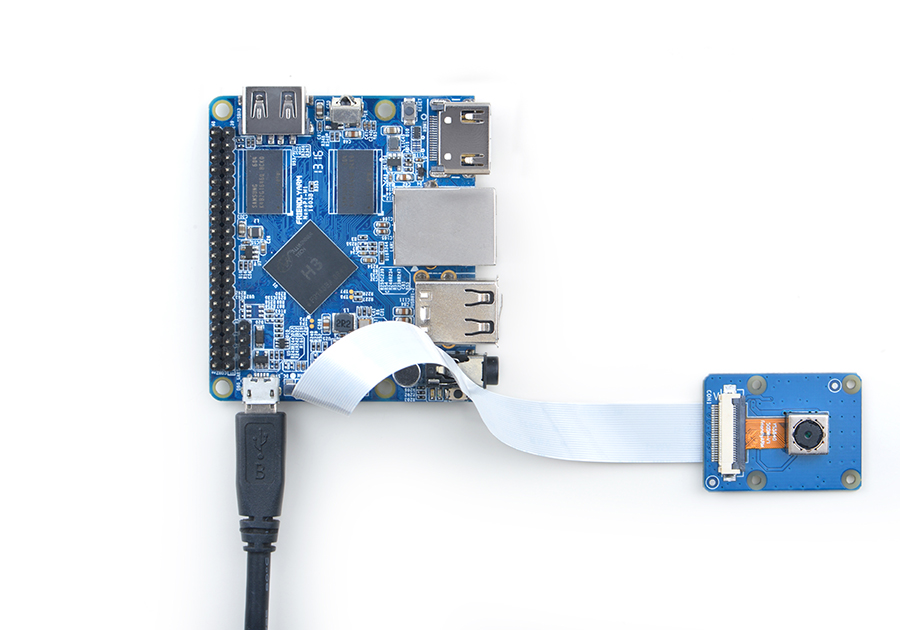
Boot Debian, connect your M1 to a network, log into the board as root and run "mjpg-streamer":
cd /root/mjpg-streamer make ./start.sh
The mjpg-streamer application is an open source video steam server. After it is successfully started the following messages will be popped up:
i: Using V4L2 device.: /dev/video0 i: Desired Resolution: 1280 x 720 i: Frames Per Second.: 30 i: Format............: YUV i: JPEG Quality......: 90 o: www-folder-path...: ./www/ o: HTTP TCP port.....: 8080 o: username:password.: disabled o: commands..........: enabled
In our case the M1's IP address was 192.168.1.230. We typed 192.168.1.230:8080 in a browser and were able to view the images taken from the camera's. Here is what you would expect to observe:

The mjpg-streamer soft-encodes data with libjpeg and you can hard-encode its data with ffmpeg which will greatly increase CPU's efficiency and speed up data encoding:
ffmpeg -t 30 -f v4l2 -channel 0 -video_size 1280x720 -i /dev/video0 -pix_fmt nv12 -r 30 \ -b:v 64k -c:v cedrus264 test.mp4
By default it records a 30-second video. Typing "q" stops video recording. After recording is stopped a test.mp4 file will be generated.
5.11 Connect NanoPi M1 to USB Camera(FA-CAM202)
The FA-CAM202 is a 200M USB camera.
In this use case the NanoPi M1 runs Debian. Connect your NanoPi M1 to an HDMI monitor. After Debain is fully loaded open a terminal and run the following command:
xawtv 0You will be able to preview with your camera Note: "0" in our case stands for the camera's device name "/dev/video0". You need to use your camera's index in this command.
5.12 Use OpenCV to Access Camera
- The full name of "OpenCV" is Open Source Computer Vision Library and it is a cross platform vision library.
- Make sure your NanoPi M1 is connected to the internet and an HDMI monitor. Boot Debian on the NanoPi M1 and login
- Install OpenCV libraries:
apt-get update apt-get install libcv-dev libopencv-dev
- Refer to the instructions in the previous sections to make sure the camera works
- Compile and run a code sample(Official Code Sample in C++ provided by the OpenCV organization):
cd /home/fa/Documents/opencv-demo make ./demo
Here is what you expect to observe:
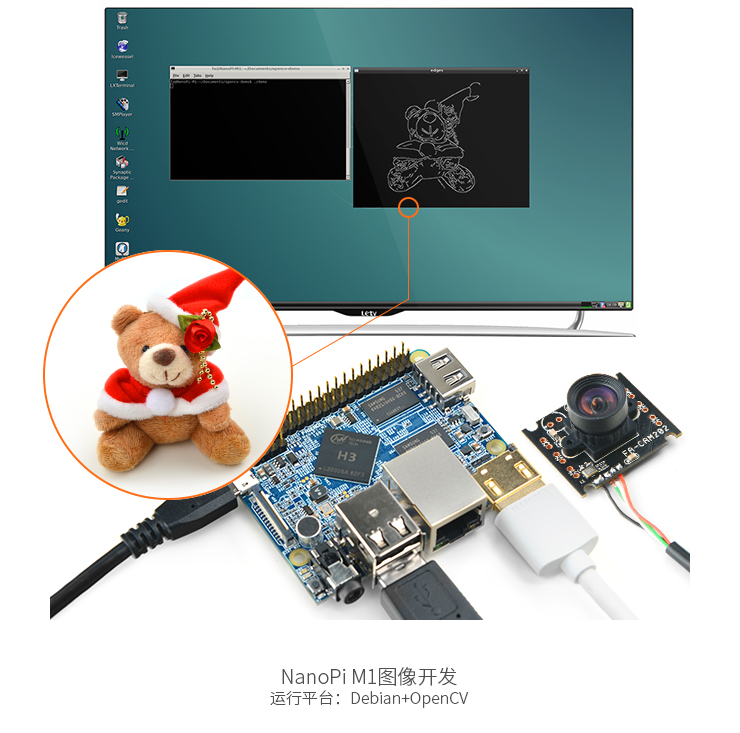
5.13 Check CPU's Working Temperature
You can use the following command to read H3's temperature and frequency
cpu_freq
6 Make Your Own Debian
6.1 Preparations
Visit this link [1] and enter the sources directory to download the nanopi-H3-bsp source code.Use the 7-zip utility to uncompress it and a lihee directory and an Android directory will be generated. Or you can get it from our github:
git clone https://github.com/friendlyarm/h3_lichee.git lichee
Note: "lichee" is the project name named by Allwinner for its CPU's source code which contains the source code of U-boot, Linux kernel and various scripts.
6.2 Compile lichee Source Code
Compilation of the H3's BSP source code must be done under a PC running a 64-bit Linux.The following cases were tested on Ubuntu-14.04 LTS-64bit:
sudo apt-get install gawk git gnupg flex bison gperf build-essential \ zip curl libc6-dev libncurses5-dev:i386 x11proto-core-dev \ libx11-dev:i386 libreadline6-dev:i386 libgl1-mesa-glx:i386 \ libgl1-mesa-dev g++-multilib mingw32 tofrodos \ python-markdown libxml2-utils xsltproc zlib1g-dev:i386
Enter the lichee directory and un the following command to compile the whole package:
cd lichee ./build.sh -p sun8iw7p1 -b nanopi-h3
After this compilation succeeds a u-boot, Linux kernel and kernel modules will be generated
Note: the lichee directory contains a cross-compiler we have setup. When the build.sh script runs it will automatically call this cross-compiler.
6.3 Package System Modules
./gen_script.sh -b nanopi-m1
This command copies the generated executables including u-boot and Linux kernel and configuration files to the "lichee/tools/pack/out/" directory and generates a script.bin.
The script.bin file is designed by Allwinner for its CPUs. For more details refer to script.bin.
Run the following commands to update the uboot on your MicroSD card:
./fuse_uboot.sh /dev/sdx
Replace the "/dev/sdx" with the actual device name of your MicroSD card.
The uImage and kernel modules are under the "linux-3.4/output" directory. You can copy the new uImage file to your MicroSD card's boot section.
6.4 Compile U-boot
./build.sh -p sun8iw7p1 -b nanopi-h3 -m uboot
After a u-boot executable is generated some extra patches need to be patched to it. Run "./gen_script.sh" to patch this executable.
If you want to manually patch the executable refer to H3_Manual_build_howto and run the following commands to update the u-boot in the TF card:
./fuse_uboot.sh /dev/sdx
Note: you need to replace "/dev/sdx" with the device name in your system.
6.5 Compile Linux Kernel
If you want to compile the Linux kernel run the following command:
./build.sh -p sun8iw7p1 -b nanopi-h3 -m kernel
After the compilation is done a uImage and its kernel modules will be generated under "linux-3.4/output".
6.6 Clean Source Code
./build.sh -p sun8iw7p1 -b nanopi-h3 -m clean
7 Applications under Android
7.1 USB WiFi
The rtl8188etv/rtl8188eu USB WiFi modules are supported in Android.
7.2 IR Controller(RC-100)
You can use FriendlyARM's IR controller(RC-100) to navigate the Android system.
Here is a list of the function keys on the RC-100 IR controller
Key Function POWER On/Off F1 Search F2 Open Browser F3 Enable/Disable Mouse UP Move Up DOWN Move Down LEFT Move Left RIGHT Move Right OK OK Volume- Turn Down Volume Mute Mute Volume+ Turn Up Volume SETTING Go to Setting Window HOME Go to Home Window BACK Go Back to the Previous Window
After Android is loaded for the first time you need to follow the prompts on Android's GUI to enter the main window and then press F3 to enable mouse and complete the setup process by navigating "up", "down", "left", "right" and "OK".
7.3 Play 4K Video
Visit this the test-video directory of this link download link and download the 4K video file: 4K-Chimei-inn-60mbps.mp4 and copy it to an SD card or USB drive.
Boot Android on your M1(512M RAM) and insert this SD card or USB drive to your M1. After locate the 4K video file with ESFileExplorer click on and play it with Android's Gallery player.
In our test playing this 4K video file from a USB drive worked better.
8 Make Your Own Android
8.1 Preparations
Visit this link [2] and enter the "sources" directory to download the nanopi-H3-bsp source code.
Use the 7-zip utility to uncompress it and a lihee directory and an Android directory will be generated. Or you can get it from our github:
git clone https://github.com/friendlyarm/h3_lichee.git lichee
Note: "lichee" is the project name named by Allwinner for its CPU's source code which contains the source code of U-boot, Linux kernel and various scripts.
8.2 Compile lichee Source Code
Compilation of the H3's BSP source code must be done under a PC running a 64-bit Linux.The following cases were tested on Ubuntu-14.04 LTS-64bit:
sudo apt-get install gawk git gnupg flex bison gperf build-essential \ zip curl libc6-dev libncurses5-dev:i386 x11proto-core-dev \ libx11-dev:i386 libreadline6-dev:i386 libgl1-mesa-glx:i386 \ libgl1-mesa-dev g++-multilib mingw32 tofrodos \ python-markdown libxml2-utils xsltproc zlib1g-dev:i386
Enter the lichee directory and un the following command to compile the whole package:
cd lichee ./build.sh lunch
Select 2. sun8iw7p1-android-dolphin to compile the whole package and generate U-boot, Linux kernel and kernel modules.
Note: the lichee directory contains a cross-compiler we have setup. When the build.sh script runs it will automatically call this cross-compiler.
8.3 Compile Android Source Code
Attention: before you start to compile the Android system you must compile the lichee.
- Setup Compiler
Run the following commands on a host PC running 64-bit Ubuntu-14.04 LTS-64bit:
sudo apt-get install bison g++-multilib git gperf libxml2-utils make python-networkx zip sudo apt-get install flex libncurses5-dev zlib1g-dev gawk minicom
For more details refer to :android_initializing。
- Install JDK
We used the JDK1.6.0_45. You can get it from Oracle: Oracle JDK . In our test we installed it in the /usr/lib/jvm/ directory.
- Compile System
cd lichee export PATH=/usr/lib/jvm/jdk1.6.0_45/bin:$PATH ./gen_android_img.sh -b nanopi-m1 -t android
After the above commands are finished an Android image "sun8iw7p1_android_nanopi-h3_uart0.img" will be generated under the "lichee/tools/pack/" directory.
8.4 Clean Source Code
./build.sh -p sun8iw7p1_android -b nanopi-h3 -m clean
9 More OS Support
9.1 Ubuntu-Core with Qt-Embedded
Ubuntu Core with Qt-Embedded is a light Linux system without X-windows. It uses the Qt-Embedded's GUI and is popular in industrial and enterprise applications.
Besides the regular Ubuntu core's features our Ubuntu-Core has the following additional features:
- it supports our LCDs with both capacitive touch and resistive touch(S700, X710, S70)
- it supports WiFi
- it supports Ethernet
- it supports Bluetooth and has been installed with bluez utilities
- it supports audio playing
For more details refer to Ubuntu Core with Qt-Embedded.
Flash Ubuntu-Core with Qt-Embedded to TF Card:
- Download the firmware nanopi-m1-core-qte-sd4g-20160628.img.zip (under official-ROMs) click to download
- Uncompress the file and flash the image to a TF card with win32diskimager.
- Insert this card to your NanoPi M1, power on the board and you will be able to play with your UbuntuCore
- Login name is root or fa and the password is fa
For more details visit Ubuntu Core with Qt-Embedded.
9.2 Ubuntu-MATE
Ubuntu-Mate is a Ubuntu variant and its GUI is Mate-desktop. You can login via SSH when you connect a NanoPi M1 to an HDMI monitor
FriendlyARM doesn't provide technical support for it
- Go to this link download link to download the image file nanopi-m1-ubuntu-mate-sd4g.img.zip
- Uncompress it and flash the image file to a TF card with win32diskimager under Windows
- After it is done you can boot your NanoPi M1 with this card
- Login name: "root" or "fa", Password: fa
9.3 Debian8(Jacer)
Debian8(Jacer) is a Debian 8 variant developed by a developer "Jacer". It uses Debian 8's desktop and has good support for the Chinese language. Users need to run this OS with an HDMI monitor and can login to the system via SSH.
FriendlyARM doesn't provide technical support for it.
- Please visit here :download link to download its image file Debian8(unofficial-Jacer).rar.
- Uncompress it and flash the image file to a TF card with win32diskimager under Windows.
- After it is done you can boot your NanoPi M1 with this card
- Login name: "fa", Password: fa
Note: When the NanoPi M1 is connected to an HDMI monitor and runs Debian8(Jacer) we don't suggest login to the system as root. If you do that the HDMI monitor will show black instead of a Debian8 GUI;
Debian8(Jacer) is integrated with GPU drivers, H264 and H265 hard decoding code. It defaults to the HDMI 720P configuration. If you want to modify its resolution to 1080P you can set the "HDMI MODE =" setting in the script.fex (under the "/boot" section) to the 1080P definition and use the corresponding script.bin file. For more details refer to the h3disp.sh file;
Debian8(Jacer) supports these WiFi card models: 8192cu, 8188cus, 8188eu, rt3070.
Debian8(Jacer)has the following support too:
- 1.Mali400 GPU driver
- 2.mpv hard decoding H264, H265
- 3.Chromium and flash
- 4.Netease's feeluown
- 5.Games such as Chess and Minesweeper
- 6.retroarch game simulator
- 7.Virtual memory
- 8.Dynamic frequency scaling
- 9.aria2 download utility
- 10.samba
- 11.WiFi cards: 8192cu/8188cus/8188eu/rt3070/rt2800/rt5370
- 12.GIMP utility
- 13.SSH
- 14.xrdp and vnc
- 15.HTML5 media player
- 16.goldendict
- 17.audacious music player
- 18.pulseaudio volume control utility
- 19.USB bluetooth
9.4 Android(Jacer)
Android(Jacer) is an Android4.4.2 variant developed by a developer "Jacer". It uses Android's desktop. Users need to run this OS with an HDMI monitor and can login to the system via SSH.
FriendlyARM doesn't provide technical support for it.
- Download image files and utilities
1. Please visit here :download link to download its image file Android(Beelink_X2_v205k4_for_NanoPiM1).
2. Download Windows utility (HDDLLF.4.40)download link for formatting a TF card.
3. Download Windows utility (PhoenixCard)download link for flashing Android image files.
- Make Android TF Card
1. On a Windows PC run the HDDLLF.4.40 utility as administrator. Insert a TF card(at least 4G) into this PC and format it. After formatting is done take out the TF card;
2. Insert it into the PC again and format it with Windows internal format utility to format it to FAT32. After this formatting is done take out the card;
3. Insert the TF card you made in the previous step into a Windows PC and run the PhoenixCard_V310 utility as administrator. On the utility's main window select your TF card's drive, the wanted image file and click on "write" to start flashing the TF card.
Note: none of the above steps should be missed otherwise the TF card you made may not work.
- Boot Android
1. Insert an installation TF card into an M1, power on the board and you will be able to work with it
Android(Jacer) supports these WiFi cards: rtl8188etv, rt8188eus and rt8189.
Android(Jacer) has the following features:
- 1. the menu bar can be set hidden; a power button can be added; dynamic frequency scaling is enabled
- 2. GAAPS
- 3. it supports rtl8188etv/eus 8189 WiFi cards and CSR bluetooth
- 4. relative low working voltage and low working temperature
For details about its full features try it by yourself:)
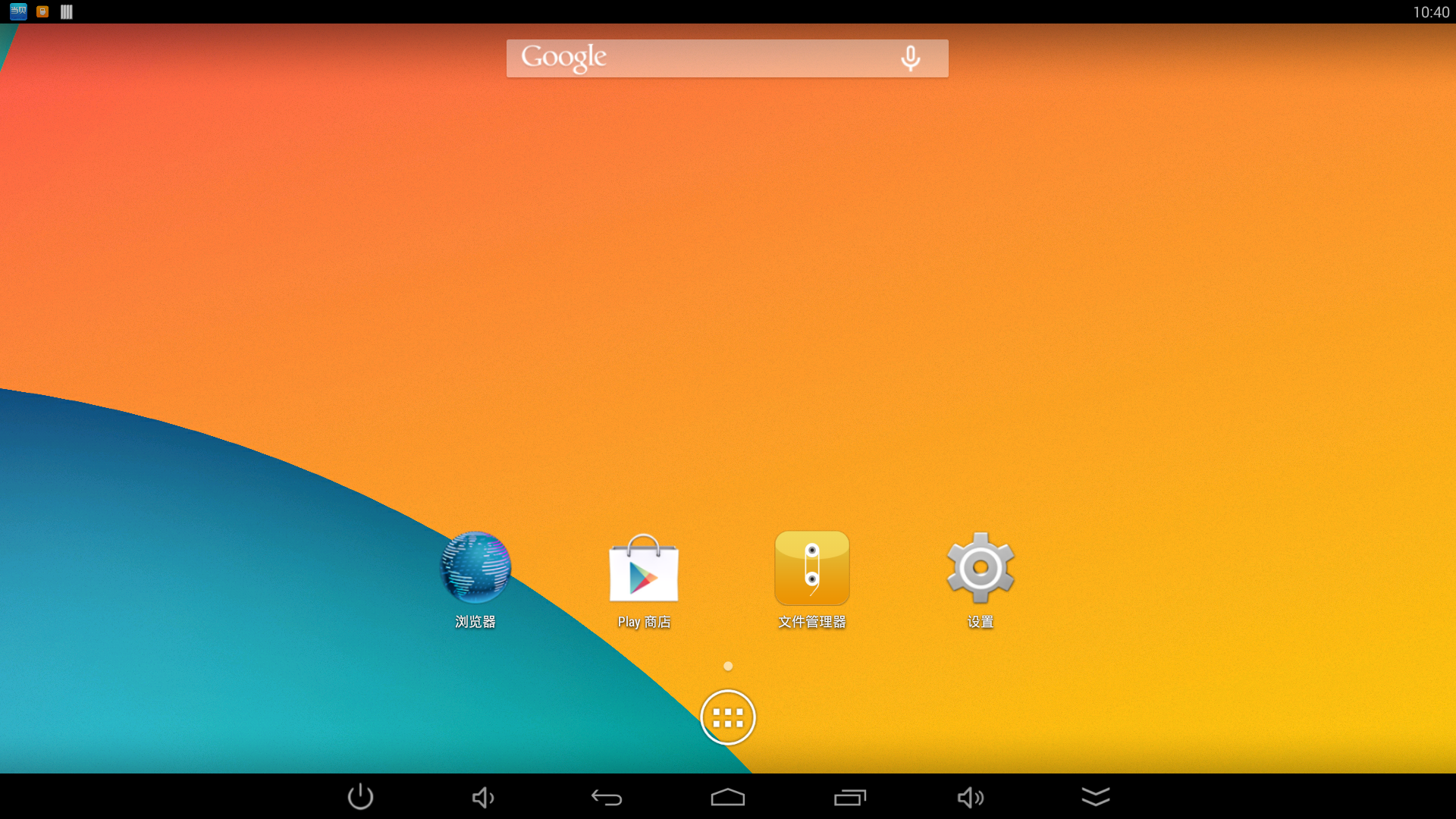
9.5 Armbian
For image download links and instructions visit Armbian's page for the NanoPi M1:armbian-m1
Armbian provides a server and a desktop versions. Here is how the desktop GUI looks like:
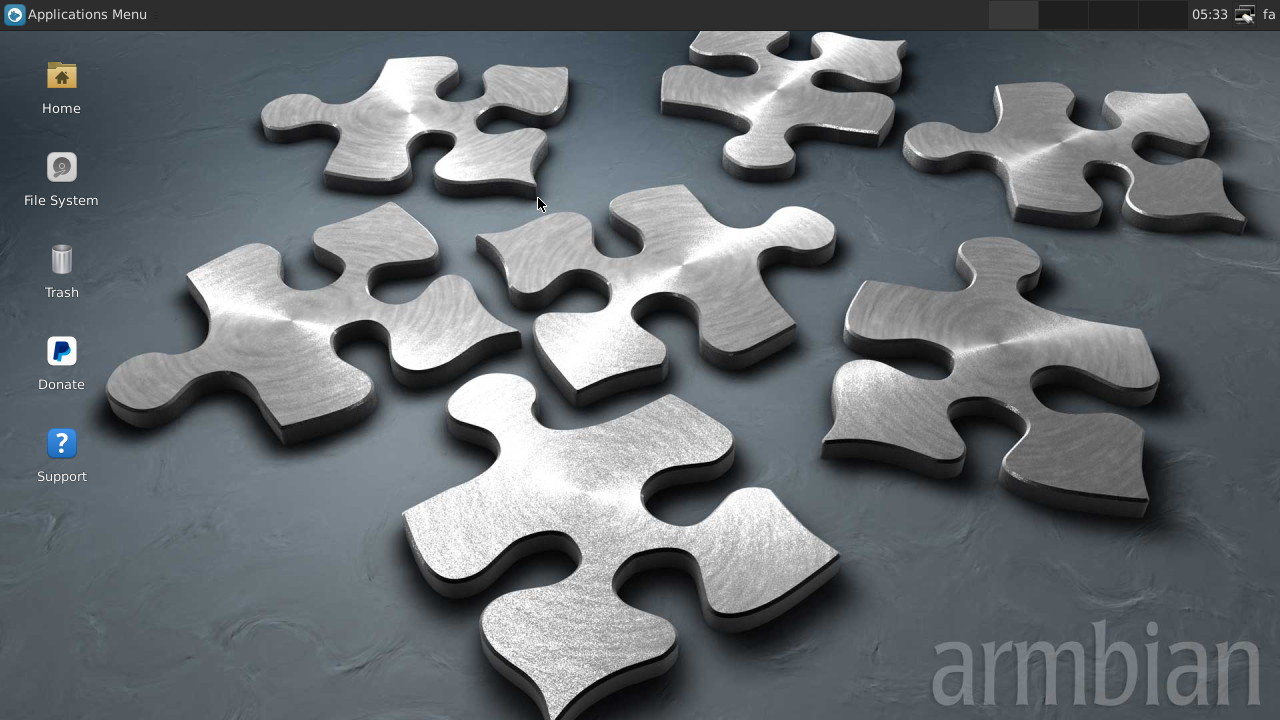
9.6 OpenWRT
OpenWRT was migrated to the M1 by one hobbyist "Tom".
FriendlyARM doesn't provide technical support for it.
- Visit download link to download openwrt-sunxi-NanoPi_M1-sdcard-vfat-ext4.img(unofficail-ROMs directory).
- Uncompress the file and you will get openwrt-sunxi-NanoPi_M1-sdcard-vfat-ext4.img.
- Insert a microSD to a host PC running Ubuntu and check the SD card's device name by using the following command
dmesg | tail
Search the messages output by "dmesg" for similar words like "sdc: sdc1 sdc2". If you can find them it means your SD card is recognized as "/dev/sdc". Or you can check that by commanding "cat /proc/partitions"
- Go to the directory where openwrt-sunxi-NanoPi_M1-sdcard-vfat-ext4.img is located and run the following command to flash the image to your MicroSD card:
dd if=openwrt-sunxi-NanoPi_M1-sdcard-vfat-ext4.img of=/dev/sdx
(Note: you need to replace "/dev/sdx" with the device name in your system)
- After it is done insert the card to your board and power on. Here is what you expect to observe.
10 3D Housing Printing Files
- NanoPi M1 3D housing printing files:[3]
11 Matrix Compact Kit B:A Good Kit for Starters
- Matrix - Compact Kit B:click to visit
12 Resources
- Schematic
- Dimensional Diagram
- Allwinner H3 datasheet Allwinner_H3_Datasheet_V1.2.pdf
- Matrix Modules & Wiki Sites:
- Button
- LED
- A/D Converter
- Relay
- 3-Axis Digital Accelerometer
- 3-Axis Digital Compass
- Temperature Sensor
- Temperature & Humidity Sensor
- Buzzer
- Joystick
- I2C(PCF8574)+LCD1602
- Sound Sensor
- Ultrasonic Ranger
- GPS
- Matrix - Compact Kit
- Fire Sensor
- CAM500A Camera
- BAll Rolling Switch
- 2'8 SPI Key TFT 2.8" SPI LCD
- IR Counter
- IR Receiver
- L298N Motor Driver
- MQ-2 Gas Sensor
- MQ-3 Gas Sensor
- One_Touch_Sensor
- _Photoresistor
- _Potentiometer
- Pressure & Temperature Sensor
- RGB LED
- RTC
- Rotary Encoder
- Soil Moisture Sensor
- Thermistor
- USB WiFi
- Water Sensor
13 Update Log
13.1 March-22-2016
- Released English Version
13.2 March-29-2016
- Corrected expression errors
13.3 Apr-02-2016
- Rewrote sections 4.3, 5, 6 and 8
13.4 Apr-15-2016
- Added sections 5.10, 5.11, 7 and 9
- Rewrote sections 5.9, 6.2
13.5 Apr-18-2016
- Update Features sections, "DDR3 RAM: 512MB" to "DDR3 RAM: 512MB/1GB"
- Update Board Dimension to 1603B
- Add dxf file and Schematic of 1603B to Resources section
13.6 July-07-2016
- Added sections 7, 9.5, 9.6 and 11
13.7 Sep-08-2016
- Added sections 5.10
- Updated sections 5.11
13.8 Nov-03-2016
- Updated section 5.10
13.9 Dec-09-2016
- Updated section 5.8, 6.1, 8.1 and 8.3
- Added section 7.3
